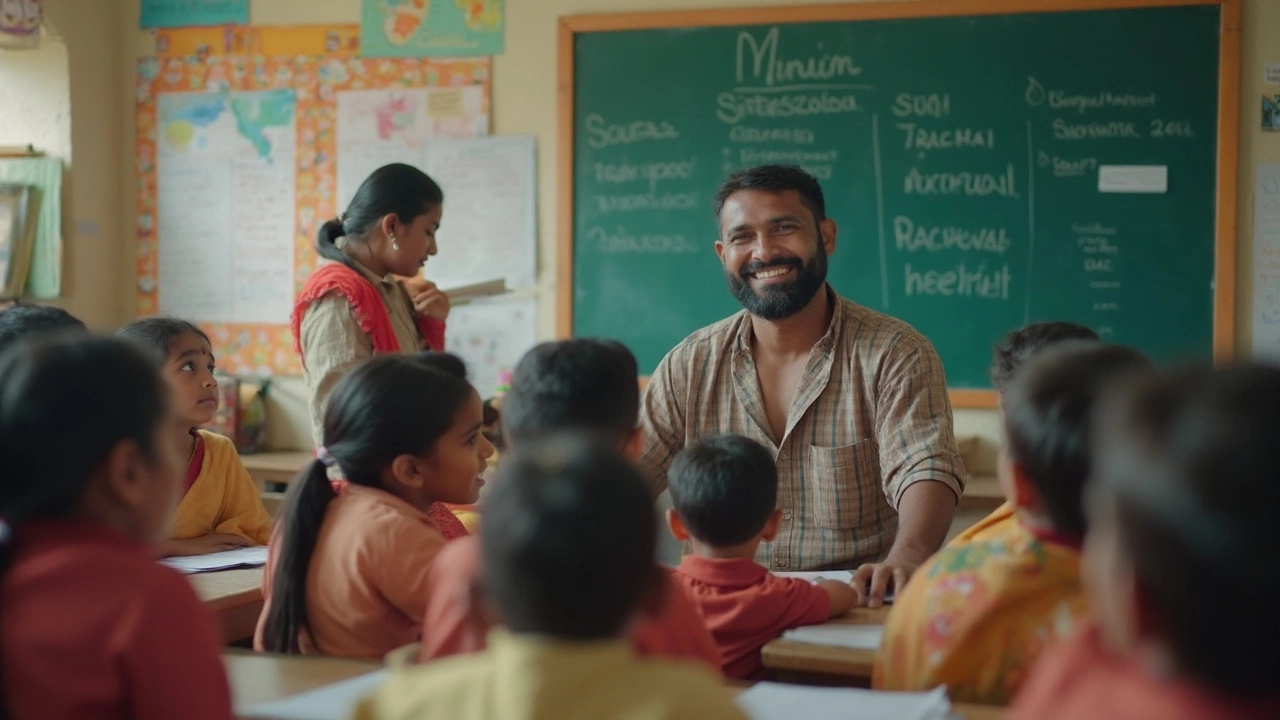
Most people think teachers just walk into a classroom and start teaching—but behind every confident new teacher is something called initial training. It’s not just theory from a textbook; this is the point where you pick up the habits, tricks, and mindset that’ll carry you through the ups and downs in a real classroom.
Initial training is what gives future teachers a fighting chance. It throws you into mock lessons, practice classrooms, and some head-scratching scenarios with real students. Wondering how to handle a suddenly rowdy class, or what to do when half your students ‘don’t get it’? You’ll practice that during your training, often with an experienced mentor watching your back.
- What is Initial Training and Why Does it Matter?
- What Happens During Initial Teacher Training?
- The Challenges Every Trainee Faces (And How to Beat Them)
- Smart Tips to Get the Most from Your Initial Training
What is Initial Training and Why Does it Matter?
Initial training is like a new teacher’s bootcamp. It’s that structured time before you officially become a teacher, where you learn core skills that will actually make your job doable—and sometimes even enjoyable. Forget Hollywood’s version where teachers just ‘wing it’ from day one. In reality, initial training is where you build real muscle, learning what works (and what fails) inside a classroom.
This training usually blends classes at a university or college with hands-on work in real schools. In the UK, programs like PGCE or School Direct are popular, while in the U.S., you’ve got teacher preparation programs baked into undergraduate and graduate studies. So, whether you’re into science, art, or math, you’ll get tailored methods for the subject you want to teach.
But why does it matter so much? Simple. Studies from the U.S. Department of Education show that teachers who finish solid initial training programs are twice as likely to stick with the job past five years, compared to those thrown in without it. Those early years in teaching are bumpy, and this training is what keeps people from quitting when things get tough.
Check out some differences made by solid initial training:
| Without Initial Training | With Initial Training |
|---|---|
| Poor classroom control | Confident classroom management |
| Inconsistent lesson quality | Clear lesson planning skills |
| Higher dropout rates | Higher job retention |
| Stress overload | Tools for work-life balance |
So, if you’re eyeing a teaching career, the initial training isn’t just a requirement—it’s your safety net and launchpad rolled into one. It makes the difference between ‘barely surviving’ and actually making a real impact every single day.
What Happens During Initial Teacher Training?
If you think initial teacher training is just about sitting in a classroom and listening to lectures, think again. This phase is hands-on and usually split between university courses and practical school placements. You get a mix of both worlds: learning theory and putting it to the test with real students. There’s a reason every teaching career kicks off like this—it’s where you gain the habits that actually work in front of a classroom.
Here’s what typically happens:
- Initial training kicks off with courses in how students learn, basics of child psychology, and lesson planning. You dig into teaching methods across different ages and subjects.
- Classroom management is a big deal—expect to practice ways to keep students on track and deal with disruptions.
- You’ll get plenty of time in real schools. Most programs require at least 12 weeks of teaching practice, where you try out lessons, get feedback, and tweak your style.
- There’s loads of support. You usually have a mentor teacher showing you the ropes and a university tutor checking in on your progress, so you’re never just thrown in the deep end.
Check out these quick facts about what goes into teacher training:
| Component | Approximate Time Spent |
|---|---|
| University Courses | 40-50% |
| School Placements | 40-50% |
| Assignments & Portfolio Work | 10-20% |
Something you might not expect: you’ll also learn how to spot when students need extra help (like learning disabilities or language barriers) and adapt your teaching for them. By the end of this phase, you’ve not only survived a few challenging days with noisy classrooms, but you’ve picked up real strategies to connect with students and actually help them learn.

The Challenges Every Trainee Faces (And How to Beat Them)
If you’re jumping into initial training, get ready for a few bumps—every trainee hits them. Most newbies struggle with time management. Juggling assignments, lesson planning, and actual teaching practice feels like three jobs rolled into one. According to a 2023 survey by Teacher Training Plus, 68% of new trainees wish they’d learned planning skills sooner. Tackling time crunch? Here’s a tip: break big projects into daily chunks and use a digital calendar—nothing fancy, just reliable reminders.
Nerves and classroom confidence are another big hurdle. The first time you stand in front of 30 staring kids, your hands might sweat, your voice might shake. That’s normal. The best workaround? Practice in front of friends or a small group—you’ll still mess up, but it’s a safe place to get feedback. It actually helps more than quietly rehearsing in your head.
Classroom management is the test everyone dreads. Dealing with disruptions, defusing arguments, or just getting kids to pay attention can make you question if you’re cut out for teaching. Instead of winging it, watch your mentor handle tough situations. Copy tricks that fit your style—maybe it’s a countdown, a silly attention signal, or just physically standing close to rowdy students.
Adapting your teaching to support every student is a lot harder than it sounds. Not every kid learns the same way. Some need pictures, others need hands-on activities. Schools expect you to spot these differences early. Building a toolbox of different activities and always having a plan B can keep you afloat when a lesson doesn’t click.
| Common Challenge | % Trainees Impacted | Best Counter Strategy |
|---|---|---|
| Time Management | 68% | Set daily goals, use digital reminders |
| Classroom Confidence | 55% | Practice out loud with peers |
| Classroom Management | 72% | Observe and apply mentor tactics |
| Adapting Instruction | 61% | Have backup activities, diversify your materials |
Don’t forget about feedback. It can sting when your mentor or students say something didn’t work. The smartest trainees treat feedback as a cheat code, not a scolding—take notes, ask questions, and try again next time.
- Break work into small steps so nothing piles up.
- Test-drive classroom ideas before using them for real.
- Watch and learn: seasoned teachers are walking cheat sheets.
- Make a list of what goes wrong and what feels right after each lesson—you’ll improve way faster.
Every challenge looks massive at first, but with these workarounds, you’ll be surprised how quickly you level up.
Smart Tips to Get the Most from Your Initial Training
If you’re starting your initial training, you’ll want every hour to actually count. The reality is, a lot of your future confidence builds right here. Don’t just coast—tackle it full-on. Here’s how you make it work for you, instead of just ticking boxes until you finish.
- Ask Questions—Loads of Them: Nobody expects you to know everything at the start, so lean into that. Bug your mentors and course instructors with anything, from how to handle that one impossible student to how to actually build a lesson plan that makes sense. If you don’t get something, keep asking until it clicks. Research from the Sutton Trust in the UK found trainees who asked more questions ended up more ready for solo teaching.
- Practice Like It’s the Real Thing: Don’t treat your practice lessons like a rehearsal. Pretend every session is game day—you’ll get more real experience, and you’ll catch your habits faster. Start each lesson with a clear goal in mind and ask for nitty-gritty feedback.
- Get to Know Different Teaching Styles: Observe a few teachers in action, not just your assigned mentor. Watching how three or four teachers manage the same class can show you a ton about what works (and what definitely doesn’t). Jot down what you’d want to use and what you’d never repeat.
- Don’t Just Collect Resources—Learn How to Use Them: It’s easy to drown in handouts and teaching websites. Focus instead on understanding why a certain tool or strategy works in a real situation. Try one thing at a time, see what happens, and tweak it.
- Find Time for Reflection: Keep a teaching journal. At the end of each day, scribble what went well, what felt awkward, and what you’d do differently. A study from Harvard showed that teachers who reflected daily improved faster than those who just powered forward without looking back.
This is the best time to mess up and learn from it. The more open you are now, the less panicked you’ll feel when you’re finally on your own in a classroom full of students waiting for you to lead the way.
